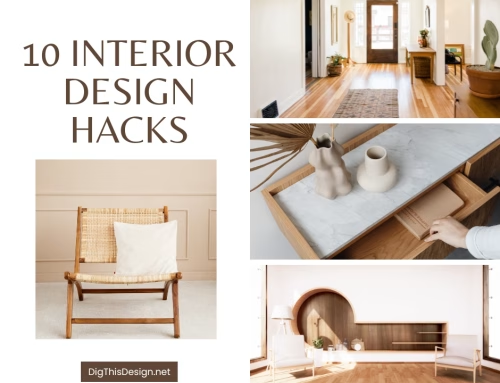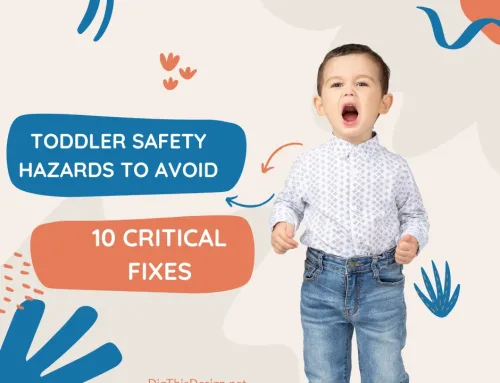Table of Contents
ToggleBringing a baby into your home is a joyous occasion. Still, it also requires careful preparation to ensure their safety. Babyproofing your home is essential for creating a secure environment where your little one can explore and grow. To help you get started, we’ve compiled a list of ten expert-approved tips for babyproofing your home, transforming it into a safe haven for your child.
10 DIY Tips for Babyproofing Your Home

1. Secure Furniture and Appliances
Securing heavy furniture and appliances is one of the most crucial steps in babyproofing your home. Babies love to pull themselves up on anything within reach, and unsecured items can easily topple over. Use furniture anchors or brackets to attach bookcases, dressers, and TVs to the wall. This simple step is key in babyproofing your home and preventing potentially serious accidents.
2. Install Safety Gates
Installing safety gates is an effective way to keep your baby away from dangerous areas. Use gates to block off stairs, kitchens, bathrooms, and any other rooms that might pose a risk. Make sure to choose gates that are sturdy and meet safety standards. Pressure-mounted gates are suitable for doorways, while hardware-mounted gates are best for the top of stairs, which is essential in babyproofing your home.
3. Cover Electrical Outlets
Electrical outlets are a common hazard for curious babies. To avoid any accidents, cover all unused outlets with safety plugs or outlet covers. There are even sliding outlet covers available that allow easy access for adults while keeping little fingers safe, which is a crucial aspect of babyproofing your home.
4. Lock Cabinets and Drawers
Babies are naturally curious and love to explore, often leading them to open cabinets and drawers. To keep hazardous items out of reach, install childproof locks on all cabinets and drawers that contain cleaning supplies, medicines, sharp objects, and other dangerous items. Magnetic locks are a popular choice because they are easy for adults to use but challenging for children to figure out. Locking cabinets and drawers is a fundamental step in babyproofing your home.
5. Use Corner and Edge Bumpers
Furniture with sharp corners and edges can pose a significant risk to a baby who is learning to walk. To prevent injuries, use corner and edge bumpers on coffee tables, desks, and other furniture pieces. These soft, cushioned bumpers can help protect your baby from painful bumps and bruises, which is an important part of babyproofing your home.
6. Anchor Rugs and Carpets
Rugs and carpets can be a tripping hazard for both babies and adults. Ensure that all rugs are anchored securely to the floor using non-slip pads or double-sided tape. This will prevent them from slipping or bunching up, reducing the risk of falls and contributing to effectively babyproofing your home.
7. Keep Small Objects Out of Reach
Babies tend to put everything in their mouths, making small objects a choking hazard. Keep small items such as coins, buttons, batteries, and small toys out of reach. Regularly check the floor and low surfaces for any objects that could pose a risk and remove them promptly. Keeping small objects out of reach is vital in babyproofing your home.
8. Install Window Guards
Windows can be a dangerous area for curious toddlers. Install window guards or stops to prevent windows from opening more than a few inches. This will help prevent accidental falls. Additionally, keep furniture away from windows to discourage climbing, an essential step in babyproofing your home.
9. Check Your Smoke and Carbon Monoxide Detectors
While babyproofing your home, don’t forget about the importance of fire safety. Ensure that your smoke and carbon monoxide detectors are functioning correctly and have fresh batteries. Place detectors in key areas of your home, such as the kitchen, bedrooms, and hallways. Test them regularly to ensure they are working properly. This is a critical component of babyproofing your home.
10. Babyproof the Bathroom
Bathrooms are full of potential hazards, from water to cleaning products. To babyproof your bathroom, start by keeping the toilet lid closed and using a toilet lock. Store all cleaning supplies, medications, and toiletries in locked cabinets. Use a non-slip mat in the bathtub and never leave your baby unattended during bath time. Babyproofing the bathroom is a crucial aspect of babyproofing your home.
Babyproofing your home is a vital step in ensuring your child’s safety as they begin to explore their environment. By following these ten essential tips, you can create a safe haven for your little one. Remember, babyproofing your home is an ongoing process that requires regular updates and adjustments as your baby grows and becomes more mobile. Stay vigilant and proactive to keep your home a safe and secure place for your child to thrive.
By implementing these strategies, you can ensure that babyproofing your home is thorough and effective, providing peace of mind and a safe environment for your child to explore and grow.
Other posts you might enjoy
Baby-Poof Cabinets Unveiled: 9 Powerful Tips for Safeguarding Your Home
Nursery Design Marvel: 3 Powerful Tips for Stylish Perfection





